|
Related FAQs: Cnidarians for Small
Volumes, Small
Marine Set-Up, Small Marine
Systems 2, Small
Marine Systems 3, Small Marine
Systems 4, Small Marine Systems
5, Small Marine Systems 6,
Small Marine Systems 7, Small Tanks, Small System Set-Ups 2, Small System Lighting, Small Marine System Lighting 2,
Small System Filtration,
Skimmers for Small Systems,
Small System Stocking,
Small Marine System Livestocking
2, Small Marine Stocking 4,
Small Marine Stocking 5, Small Marine Stocking 6, Small Marine Stocking 7, Small Marine Stocking 8, Small Marine Stocking 9, Small Marine Stocking 10, Small Marine Stocking 11, Small Marine Stocking 12, & Small System Maintenance, Maintaining Small Systems 2,
Maintaining Small Systems 3,
Maint. Sm. Sys. 4, Maint. Sm. Sys. 5, Maint. Sm. Sys. 6, Maint. Sm. Sys. 7, & Small System Disease,
Related Articles: Nano Reef Systems by Adam
Jackson, It's a Small World, Pico Tanks, By Kirby Adams,
Tom Walsh's Small
Reefs, Moving
Aquariums, Marine
Planning, Getting Started with a Marine Tank By
Adam Blundell, MS, Marine Biotope, Marine Landscaping, Fishwatcher's
Guides,
/Series: Livestocking Small: Pico, Nano,
Mini-Reef's....... Marine Systems under 40 Gallons
Echinoderms; Seastars, Brittlestars, Sea Lilies & Sea
Cukes for Small Marine Systems
|

|
|
By Bob Fenner
|
|
 |
 |
 |
Small Marine Aquariums
Book 1:
Invertebrates, Algae
New
Print and
eBook on Amazon:
by Robert (Bob) Fenner |
Small Marine Aquariums
Book 2:
Fishes
New
Print and
eBook on Amazon: by Robert (Bob) Fenner |
Small Marine Aquariums
Book 3:
Systems
New
Print and
eBook on Amazon:
by Robert (Bob) Fenner |
Surprising to many people is just how many numbers of
spiny-skinned animals make up rocky reef fauna. In fact, they are the
determinant group of life to be found there. Cursory careful
observation, especially diving by night will reveal just how important
this group is. Indeed, it has been written that they ARE the animals in
shallow to deeper seas that to large extent decide what else lives
there.
Though most species of stars, sea cucumbers and crinoids get too large
for the smallish systems in our purview here, there are quite a few
suitable members that are on/off available to hobbyists.
Seastars of (Small) Size/Use:
|
Not sand-sifting stars. These are just
too efficient at cleaning up (eating) so
much interstitial fauna (between
substrate grain biota). Should really
only be stocked (if used at all) at one
per hundred, two gallons.
Shown, one of a few commonly employed
sand sifting Seastars, Archaster
typicus
|

|
|
Asterinas, no! Asterinas, yes.
This delightful genus hosts a myriad of
small; at times colorful (blues, greens,
reds…) species of small stars. They feed
largely on algal films, but may disturb
other encrusting life if allowed to
reproduce to high density (keep the herd
thinned).
|

|
My Favorite Genus, Fromia:
What are we
all looking for in livestock? For organisms that look attractive, are
interesting behaviorally, which are hardy and adaptable… and readily
available and not too dear/expensive. Amongst the Asteroids, this
translates best as members of the genus Fromia. They’re gorgeously
coloured and marked; out and about vs. shy and retiring most of the
time, survive shipping and handling well, and generally don’t cost the
proverbial (Seastar) arm or leg.
Some best examples below: Fromia elegans, F. ghardaqana, F. indica,
F. milleporella, F. monilis, and F. nodosa.
Stars That Aren’t (To Avoid):
|
Asteroids to give a pass are many.
Too many of those offered in the trade
are altogether unsuitable… getting too
big, shipping poorly, just dying easily
most the time… And some are predaceous.
Some notable examples to pass up: At
right, the genus Linckia (here
L. laevigata, but the whole genus is
bunk)… dismal survival history.
Below: The popular, but
short-lived Chocolate Chip Star,
Protoreastor nodosus, lastly, the
African or Horned Seastar, P. lincki,
predator of other sessile invertebrates.
|

|
|

|

|
Brittlestars; Fabulous Little
Ones:
To heck with opportunistic omnivores like Hermit Crabs, and mysterious
and lazy non-cleaner-upper snails; my vote for best clean-up crew
members goes to small Brittlestars. Sometimes you can buy these outright
from your stockist/LFS; other times, if you can secure very healthy live
rock they may just “pop up” as hitchhikers. The systematics of small
species, identification of small specimens is difficult, but here I’ll
provide you with some image examples.
|
Ophiothela danae
on an arborose sponge in Malaysia’s
Palau Redang at right.
Below, Ophiothrix suensonii,
a delightful common Indo-Pacific
hitchhiker; here on a unifacial pinkish
sponge.
A freebie on atop a mushroom at
the 2008 Interzoo show. You need to keep
an eye on the individuals and population
of Ophiuroids in your system to assure
they’re not getting too large or
predaceous.
|

|
|

|

|
Brittle/Serpent Stars to Avoid! Too predaceous
and/or too big
|
A former darling, but blatant fish
eater, the Green (Deathstar!),
Ophiarachna incrassata. Becomes too
large for our consideration anyway.
Below, a frequent offering,
Ophiothrix rubicundum or
Ophioderma squamossimum in the wild.
Oh, and a big pile of them at a Los
Angeles wholesaler. A good scavenger and
reef safe, but too large and hungry for
small systems.
|

|
|

|
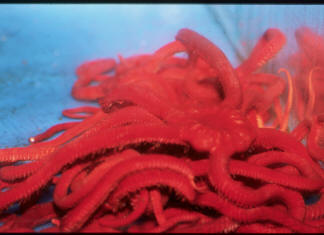
|
Gadzooks, Tiny Cukes!:
Most Holothuroids get way too big for forty gallon or less volumes; and
many of them have a nasty reflex defensive mechanism (see below). These
Cuvierian Tubules are not just ungodly sticky, but venomous… if
released, resulting in the loss of all livestock. Stick with the
non-venomous, small species.
Some of the best choices and the very worst below:
|
Colochirus robustus
Ostergren 1898, the Yellow Sea Cucumber.
To four inches in length.
|
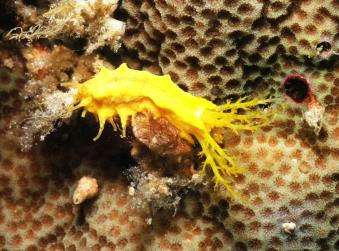
|
|
Pentacta anceps,
the Red Sea Cucumber. To a maximum
length of about three inches. Plankton
feeder, requiring large refugium
contributions and/or cultured materials
(e.g. Artemia).
|
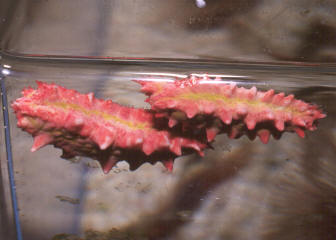
|
Beware This Destroyer of
Worlds:
|
Am surprised and disappointed that
the
Sea Apple, Violet Sea Cucumber
is still sold in our interest...
Pseudocolchirus violaceus (Theel
1886), et al. species, can be deadly
toxic if disturbed... Sensitive to poor,
changing water quality. Largely a filter
feeder. Avoid.
|
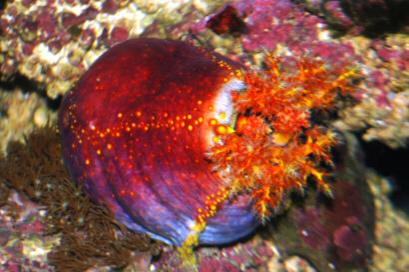
|
Crinoids; Mysteries No More:
|
Sea Lilies, according to most
pet-fish writers are near-impossible to
keep in captivity. I assure you this is
not the case. They are “sticky” to
touch, and therefore problematic to move
(best to gently prod, have “walk up” net
handles and bag underwater). Crinoids
require seasoned (month’s established)
systems with other peaceful tankmates;
and some care in feeding (small
materials; either from a refugium or
blended by you; fed using a timer to
temporarily switch off your mechanical
filtration). Look for a smallish
specimen (3-4 inches in diameter) that’s
been at your shop for a week or more.
Pay attention to its size; as they will
shrink in time if undernourished.
Crinoids
occur in all colors of the rainbow;
often two-tone.
|

|
No Urchins For You!
|
There are some small species of
Echinoids, of a few inches test
diameter; but these rarely show up in
the trade. The non-spiny (slate, pencil)
urchins get too big… frequently starving
even in huge systems; and like their
pin-cushioned cousins can push landscape
over… IF some small individuals show up
on your live rock, so be it; but I would
not buy them for stocking.
At right, too toxic Athenosoma varium;
below: Too spiky Diadema antillarum;
bottom right Pencil/Slate Urchin,
Heterocentrotus mammillatus; just
too large.
|
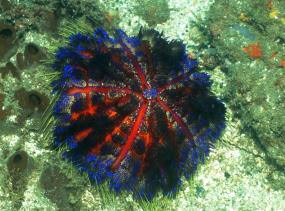
|
|

|

|
Echinoderm Selection Criteria:
1)
Look carefully for blemishes, bulges, evacuolations in the bodies
of prospective purchases, and those of other echinoderms in their
system. Animals with such “blems”, missing arms, tube feet… rarely
survive.
2)
Select the more active individual/s… ignore those “just sitting
there”. Motility is a good indication of vitality.
3)
Ask the animals to be fed in front of you. Even just some “food
juice” added to an echinoderms system elicits action; demonstrable
activity.
4)
Don’t buy “just arrived” specimens; never at “midnight madness”,
“still in the bag” special sales. Most echinoderms die within a day of
arrival at each step in the chain of custody… Let them rest before
moving again.
Cloze:
The Echinodermata is placed right next to the Chordata, the phylum that
includes the fishes, and us. These are advanced organisms; some smaller
ones suitable for aquariums of a few tens of gallons. They have similar
needs for high, consistent water quality, a dearth of metabolites and no
measurable metal in their water. In moving them, do keep them submerged
(trapped air in their bodies can be trouble). Will you be fortunate to
“inherit” spiny-skinned animals with your live rock? Maybe even purchase
them directly?
 |
 |
 |
Small Marine Aquariums
Book 1:
Invertebrates, Algae
New
Print and
eBook on Amazon:
by Robert (Bob) Fenner |
Small Marine Aquariums
Book 2:
Fishes
New
Print and
eBook on Amazon: by Robert (Bob) Fenner |
Small Marine Aquariums
Book 3:
Systems
New
Print and
eBook on Amazon:
by Robert (Bob) Fenner |
|
|

